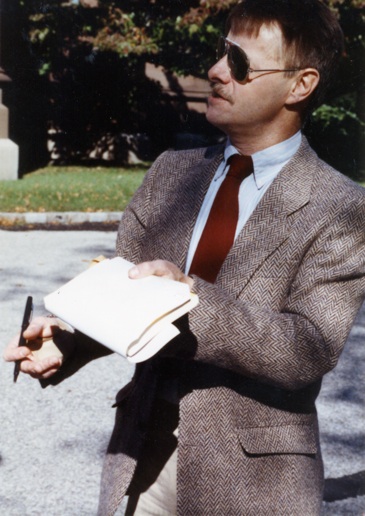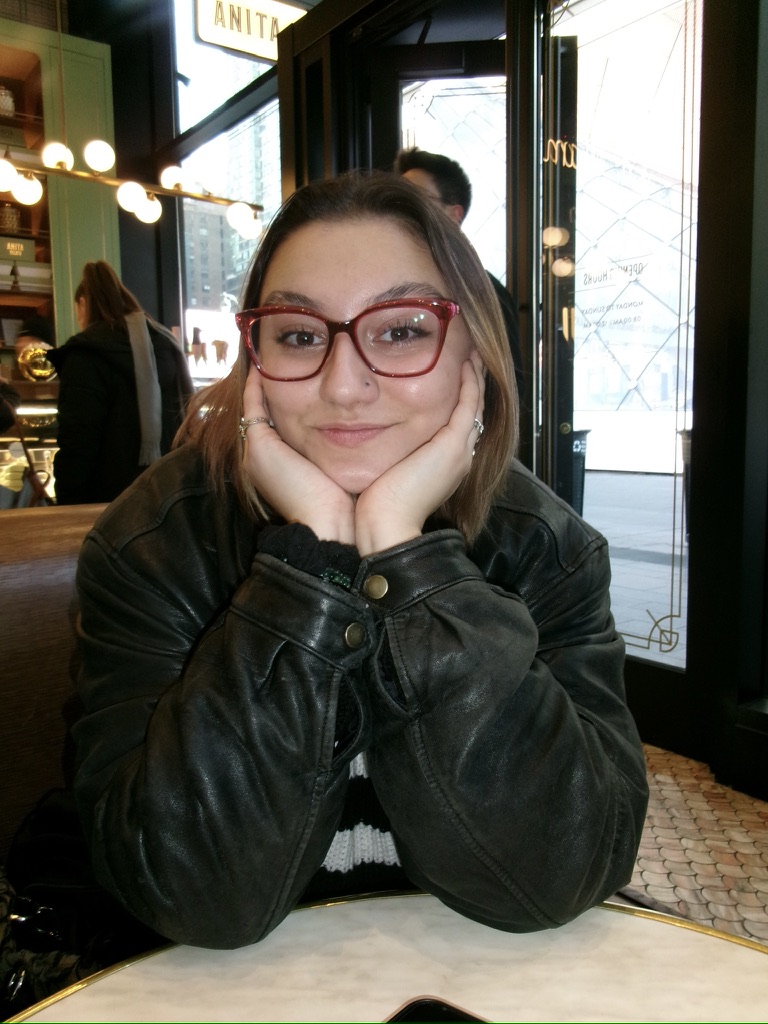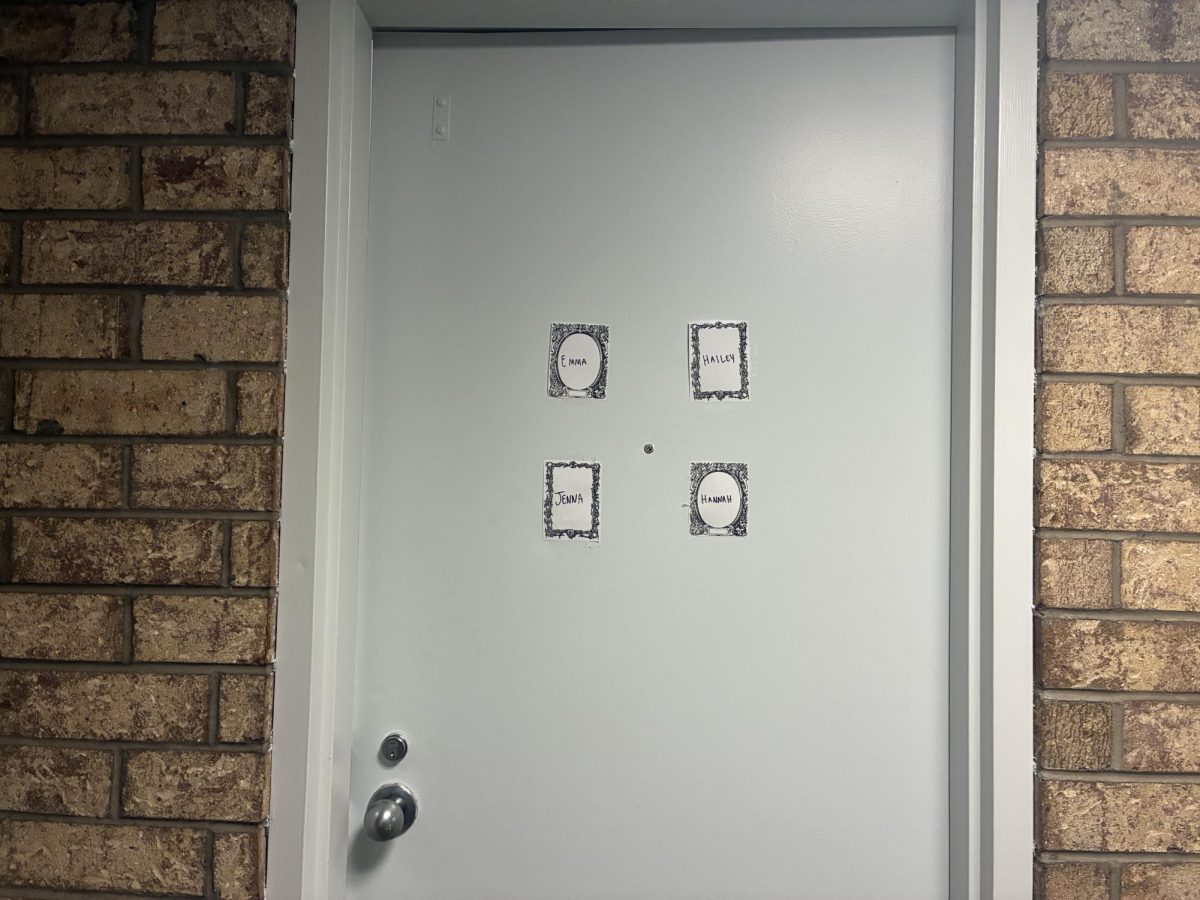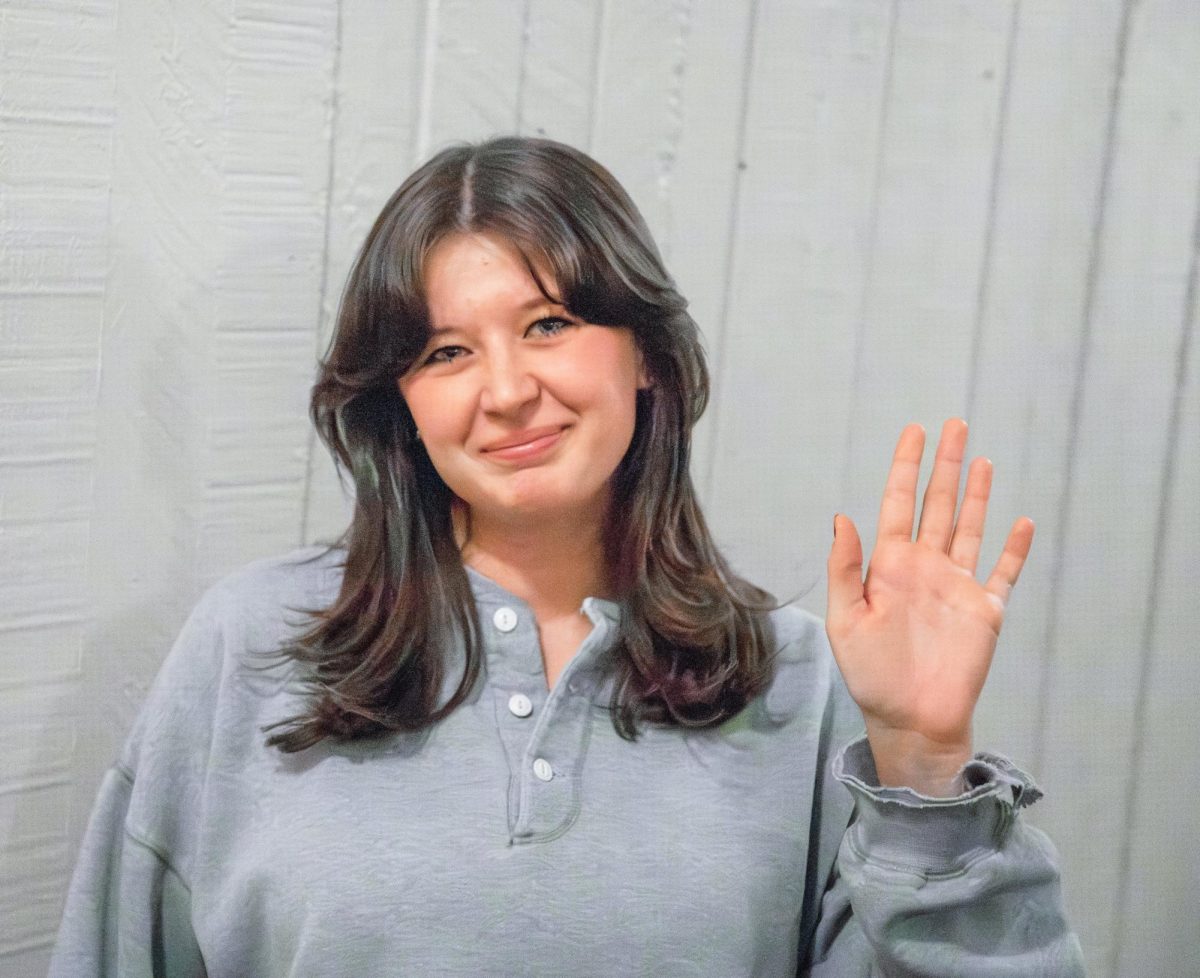
I’ve said for a while now that the goal of art should be to be memorable. When I entered my 20th Century European Painting class for the first time, I thought I knew what was coming: a boring class taught by somebody who was easily forgettable. In comes this guy with an anti-war pin on his lapel at almost a jogging pace, and when he started talking out came pure, unfiltered joy. It hit me that this was going to be good. Like art in general sometimes, he is not for everyone, and I only recommend him to serious students that can match his love for art. He is so smart that at first it takes time to understand him, almost like he is speaking a different language. You will get used to it. A semester goes by and Professor Joseph Masheck now ranks very highly on my list of favorite professors. I respect passion. I respect people that follow their destiny. Did we see eye to eye on everything? Of course not – however, I do notice I find myself agreeing with him more and more. He’s funny, and he is an unbelievably nice man. I contact him with all my questions regarding my own art and eagerly await his replies. I had the pleasure of interviewing him about his own art and what he teaches.
Where did you go for your undergraduate and graduate school degrees?
I went to Columbia for college. It wasn’t Yuppie U in the ‘60s. Then I got a fellowship to Yale which I didn’t take, so I went back to Columbia, mostly to study under Rudolf Wittkower, a great architectural historian. I had to earn my tuition by mounting photographs for the art history department, but that was actually interesting. Many years later I took a master in letters degree in aesthetics at Trinity College, Dublin –- something I’d always wanted to do – finishing it in 2001. My thesis on what can be inferred about Cézanne’s philosophy of art became a book.
Why become an art historian and critic? What drew you to it, and at what point did you know this is what you wanted to do?
I think it has to do with my homeroom in high school. Holy Cross, in Flushing, which, like Columbia was not coeducational, and still isn’t, so sublimation was the name of the game. I still think that can be advantageous. A bunch of us would arrive early and hang out and talk casually about surprisingly cultural things. I also remember paying 10 cents admission to the Museum of Modern Art when that was the under 16 rate. I’m really lucky that a one-semester art humanities course was required of everybody in college, because nobody had ever told me that you could actually study and teach and write about stuff like Franz Kline. I was in hog heaven when I was assigned my first term paper, since it could be on anything I was already curious about, like Whistler or Mondrian, whatever. I majored in English, but I’d caught the art history bug. As many studio students know, most middle-class fathers don’t feature art for their sons. When friends asked mine what I was studying he said I was “pre-teaching” –- which I learned to live with. Thirty or forty years later I was with two of my aunts. One of them happened to mention Picasso, so I thought I would tell them I had discovered some sources for Guernica, which I’d actually published as a graduate student. They looked at each other as if I were crazy; but I’d like to know, what did they think I was doing for a living?
Who are some of your favorite artists? Can you pick an absolute favorite?
I only really got the greatness of Cézanne in my maturity, though of course I could see he was finally destroying the sheer hokum of Renaissance perspective, with Braque and Picasso finishing the job in their first great phase of cubism. It’s possible to say that postimpressionism in general already did that; but it’s one thing to give people escapist alternatives, and another thing to make it so that no respectable artist can go down that path again. But the two artists who made me want to have art history as my life’s work were Mondrian and the great architect Mies van der Rohe, both of whom I already revered on my 10 cent trips to the Modern, which by the way, New Yorkers in the know never called “MoMA”. Since the 1970s the painter Malevich has had special, spiritual importance for me. In a very wayward way I’m writing a book about his later importance to abstract painting.
If you were an artist yourself, what movement would you belong to?
I guess in a sense I can almost claim to be an artist myself; I had a show of paintings with Peter Plagens in the Hofstra Museum, and a small show in our departmental Rosenberg Gallery. But I haven’t painted in more than ten years, mostly because of books I’ve wanted to write. My paintings are abstract. People who don’t know about art might say they are geometric, but they aren’t. I try to be of my time, but if any past movement could be extended – and I don’t think they can be – styles are not just flavors. I’d want to be a suprematist, following Malevich. Suprematism has more of an expressive dimension than the constructivism that it otherwise resembles. But I can still be inspired by him, here and now, which I am.
You are the author of one of my favorite quotes. You once said that “Expressionism is the punk rock of art.” Being a huge fan of both, could you elaborate to somebody who is unfamiliar with either or both?
You’ll have to forgive the lack of musicological knowledge here. Remember, I was contrasting it with my hatred of the disco beat. I understood punk as a cultural reaction to Margaret Thatcher’s politics, and I had parallel troubles of my own, here, when the reactionary money people came in, but that was only the set-up. Hearing the music again and again, even without knowing the musicians is what really did it. By the time I went to C.B.G.B.’s that was almost a cultural duty. Only a week or so ago, however, my wife and I were in a restaurant and definitely not liking the music, which was too loud considering its appalling mediocrity. Then something came on that was by comparison so musically fine that I went to the kitchen to ask the waiter who it was by. Frank Zappa. At home I saw, thanks to Wikipedia, that Zappa is considered proto-Punk. So it all fits together!
In your opinion, what is the foremost goal of the artist?
That’s a tough question. Here is an attempt at a straight answer: for a visual artist: the articulation of visual form so as to produce insight in the viewer. And I do like the challenge of Kandinsky. That should be spiritual insight.
Do you value the aesthetics or the concepts of a piece more?
Concepts should be prioritized, because we’re not looking for Just a Pretty Face. Let’s face it: even Punk music had a strong, in that case, political, axe to grind, against the wicked Thatcher and her ilk, unfortunately as influential as ever in American politics.
You were the editor-in-chief of Artforum Magazine, from 1977 to 1980. How did you find yourself in such a great position?
I was one of the contributing editors – as I now am on the Brooklyn Rail. So when the previous editor was fired, I was one of the people brought in by the publisher to have a chat about who might be good to put at the helm. Finally he said, “Well, can you think of yourself in this position?” In the end I myself was fired when some English millionaires took over. You could see what was happening: before, I had complete editorial freedom. Even the choice of cover was entirely up to me and I did the first woman and the first black artist. The advertising man didn’t know until it went to the printer what dealer to solicit for an advertisement. Soon the thing was the house organ of the art-money business.
You have written many books about ideas and figures of the art world (including Marcel Duchamp and Adolf Loos); how do you decide who or what to write a book about?
Interesting question. The Duchamp was my first book – in fact, the editor of the series had wanted somebody to do Warhol. But I wanted to get to the bottom of something and as Andy freely admitted, he was all surface. I like Loos in many ways. First, he inspired even Le Corbusier and Mies. Second, he was a Viennese born in the Czech Lands like Freud, and that interested me personally being Czech on my father’s side and hence having to put up since youth with a lot of stupidity ‘in these parts’ about where Czechoslovakia even was. The clincher however, is that I’m a real modernist with little patience with postmodernism, and here was a chance to prove that the pomos are pretty much totally wrong about Loos. Of course that means they don’t really want to discuss the book! The most foolish reviewer said my black and white illustrations look too scholarly; he wished I’d had big glitzy color plates, even though there are about 25 Loos books like that.
Your Magnum Opus is “The Carpet Paradigm.” Would you please briefly describe it to those who haven’t heard about it?
It’s an attempt to show that the formalism of Clement Greenberg – you know, Mr. Flat-ology – derived, whether he knew it or not, from the work processes of practical designers in the 19th century. In other words, I was one-upping the ex-Marxist who despised ordinary workmanship, with my democratic socialist view of the situation. The baby of formalism had been thrown out with the bathwater of Greenberg’s like/don’t like typical American simplification of formalism. Read Roger Fry if you want to see how much formalism can mean even in the more-than-craft side of painting; or read the Russian formalists (though they didn’t say much directly about painting), right after the Revolution, before Stalin snuffed out everything good.
Could those who cherish fine arts, specifically Renaissance Painting for example, construe “The Carpet Paradigm” as an insult?
I admit I’m not interested in Renaissance perspective, which as far as I’m concerned has to do with property relations at the beginning of capitalism in the 15th century – though I do love the 15th century architecture out of which the system developed. But what I’m really against is the boring training, like dog obedience, in a certain mere devices, which became the mainstay of the academic system. No wonder why after the 1860s only crappy artists could bear submitting to it. I myself am against teaching perspective in schools and colleges: it’s just a trick, except perhaps for architecture; and anyway even the engineers basically use isomorphic perspective, as in Chinese painting, not the hot illusionistic tricks of the Italian Renaissance. There’s something ignoble about all illusionism. But those who don’t like “The Carpet Paradigm” because it disses perspective must not understand what is says about cubism, the truly modern equivalent of perspective.
Like all theories, concepts and ideas, there are those who disagree. Objectively, how would you assess the reception of your theory when it made it first public appearance?
I don’t think American modern art folks have taken the book on publicly, though some art world people admired it when it first appeared as a long article in 1976; in fact, you’re reminding me that one great enthusiast was Brian O’Doherty, a friend of the publisher of Artforum who then asked me aboard a few months later. A year or two ago the Museum of Modern Art of the City of Paris asked me to supplement it for a show of carpets and modern painting that then went to Shanghai. Also, the most important art history journal in Sweden did a whole issue on possible extensions of “The Carpet Paradigm.” The Swedes didn’t ask me to write. I think they thought I must be dead! As a matter of fact, somebody back in 1976 said that it seemed like an old man’s essay, which I took as a compliment. Here and now, everything is so dumbed-down. Greenberg has already been disposed of, so why am I trying to knock him down? I would say maybe because the whole case is interesting and in a way still holds water. The trouble is not many Americans are so dialectically inclined as to want to study the reason why something was wrong.
Have you ever met one of your heroes of the art world?
I know quite a few artists, including some famous ones on whom I wrote either the earliest or else very early pieces like Mike Bidlo, Jonathan Lasker and Tom Nozkowski. But I also had three heroic teachers: Dorothea Nyberg, whose field was French architecture but who also taught me to be more radical, Rudolf Wittkower – my second father, I used to say – whose field was Italian and British architecture and who taught me that your thoughts can range as widely as you wish so long as you cite good authorities. But Meyer Schapiro, the modernist, was a guiding light as well as the teacher whose name was known even outside our field. I have a lecture in which I argue that Schapiro was even an influence on the famous monk and peacenik Thomas Merton. I wish I could give it at Hofstra but there doesn’t seem to be any outlet for it here. It couldn’t possibly be a distinguished faculty lecture because it doesn’t have any “take-home message” except maybe be authentic.
You are retiring from teaching after next semester. Why now?
In order to work on my writing I’ve been taking a sort of semi-retirement where I teach half time for half salary. It used to be that someone could do that and change their mind three times. I really wanted to continue that; but under the present contract I could only continue that by giving a specific retirement date. As for “Why now,” I have to say, maybe you’re putting it that way because last semester’s class was so good – more than the usual number of interested and responsive students.
You call yourself a generalist. What is that exactly?
It was Wittkower who told me I should be a generalist, meaning an art historian who takes it as his brief to be responsible as far as possible for the history of art as one continuous thing. That is much more common in music. He said, once, “Never forget that to most people the history of art, per se, already seems like a very specialized subject.” As far as my own work is concerned, this has to do with my understanding that, for example, the Neolithic is the beginning of modernity. You get naturalistic cave paintings in the Paleolithic and then abstract (get it!) designs on the pots of the Neolithic – I have a little essay on that. The only trouble with being a generalist is that a lot of specialists don’t want you on their turf. But your question also concerns my more theoretical alternative to the regular art history survey, which has theory and philosophy instead of the tedious name and date approach: “Form in the Art-Work, I and II.” I designed it for the studio art program at Harvard and frankly, I’ve never understood why my colleagues here don’t think it much better for studio students than the usual art history survey, which fortunately I never had to take because I would not have done well on a baseball card memory basis.
In terms of impact, “The Scream” by Edvard Munch as the greatest painting of all time. Do you agree or disagree, and if you disagree what painting is the greatest to you?
I’m ashamed to say that I never liked that work because it’s too popular. But you’re right, it’s good. Look at the way the extremism of the surrounding landscape is crushed into the surface. Talk about impact! If I could have any one work of art at home, to gaze on at any time of day, I would wish it to be a watercolor by Cezanne, with its very thought processes exposed to view.
The invention (and subsequent widespread availability of) the camera was the greatest blessing in disguise for art. Do you agree or disagree?
The greatest blessing, for two reasons. The big reason: it freed painting, and even drawing, to be purely structural and expressive. The little reason: it made for a whole new art that can be very good. In a funny way, we are going through a phase where digital photography has made most photography really bad news, including all the souped-up gaudy landscapes available as screen savers. I got a new computer and just had to say “don’t like” to them, ten or twenty hammy landscapes at a time. They all have the same high-pitched melodramatic taste, which basically stinks. In other words, I think kids now underestimate photography. It’s like too many of them said they were interested in poetry but by that they really only meant jingles.
Do you have any advice for aspiring artists or art critics and historians?
Study the art history of any period or culture so long as the teacher appreciates that the great art of our time is abstract, and that that has implications for the past too and that the ornamental arts of the whole world are part and parcel of the pre-history and history of abstract art. Beyond that, I think you’d have to decide whether to be part of the current money game that’s discovered art as merely a legal form of insider trading; or else really be an artist, the way Nietzsche thought of that as a very high calling, and in that case study some religion to see what belief really means. I think that today, when postmodern relativism excuses people from valuing even their own modern heritage, even that notorious atheist would agree.
Who are some contemporary artists whose work you enjoy?
I feel a kinship with Helmut Federle. I think that’s why he asked me to write on the religious aspect of his work for a catalog for a Swiss museum, I don’t think he would have trusted anybody else to do it. Recently I’ve also published a long article on Mondrian’s Protestant religiosity.
Are you satisfied with your legacy in the art world?
No. I think it’s so stupid now that even scholars get away with writing books with no bibliography before 1985, meaning that they have never been to the library at all. Having published articles since the mid-1960s, that’s already been happening to me, and I hate it. Next time I have to review a book like that, I’m going to blast away. As far as art-world politics are concerned, I’m at the interesting point where certain hotshots who disliked me and curtailed my earlier efforts are now no more famous than I am, which I appreciate on a you-can’t-take-it-with-you basis. Maybe I’m just famous enough, without obligation to go to dinner parties where I’d get a migraine from having to smile despite the inanity of today’s art-world conversation. As for celebrity, I don’t like it in the abstract. And being a critic sometimes makes one the opposite of celebrated. An artist once came up to me at an opening and said, “I hope you’re satisfied, now that you have ruined my career,” but I’d never even written on him. Maybe being asked searching questions like this from a sincerely inquiring member of the younger generation is enough.













